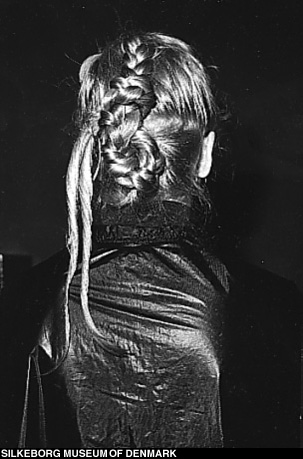
Posted on 02/26/2008 6:28:06 AM PST by blam
Vikings did not dress the way we thought

Swedish viking men's fashions were modeled on styles in Russia to the east. Archeological finds from the 900s uncovered in Lake Malaren Valley accord with contemporary depictions of clothing the Vikings wore on their travels along eastern trade routes to the Silk Road. The outfit in the picture is on display at Museum Gustavianum, Uppsala University. Photo: Annika Larsson
Vivid colors, flowing silk ribbons, and glittering bits of mirrors - the Vikings dressed with considerably more panache than we previously thought. The men were especially vain, and the women dressed provocatively, but with the advent of Christianity, fashions changed, according to Swedish archeologist Annika Larsson.
"They combined oriental features with Nordic styles. Their clothing was designed to be shown off indoors around the fire," says textile researcher Annika Larsson, whose research at Uppsala University presents a new picture of the Viking Age.
She has studied textile finds from the Lake Malaren Valley, the area that includes Stockholm and Uppsala and was one of the central regions in Scandinavia during the Viking Age. The findings, some of which were presented in her dissertation last year, show that what we call the Viking Age, the years from 750-1050 A.D., was not a uniform period.
Through changes in the style of clothing we can see that medieval Christian fashions hit Sweden as early as the late 900s and that new trade routes came into use then as well. The oriental features in clothing disappeared when Christianity came and they started to trade with the Christian Byzantine and Western Europe.
"Textile research can tell us more about the state of society than research into traditions. Old rituals can live on long after society has changed, but when trade routes are cut off, there's an immediate impact on clothing fashions," says Annika Larsson.
She maintains that Swedish Viking women in the pre-Christian period probably dressed much more provocatively than we previously believed. She bases her theory on a new find uncovered in Russian Pskov, close to Novgorod and the eastward trade routes then plied from Sweden. The find consists of extensive remnants of a woman's attire, which Annika Larsson claims does not square with the traditional picture of how Viking women dressed.
Previously it was thought that Viking women wore a long suspender (brace) skirt, with both the front and back pieces consisting of square sections, held together by a belt. Clasps, often regarded as typical of the Viking Age, were attached to the suspenders roughly at the collar bone. Under this dress they wore a linen shift, and on top of it a woolen shawl or sweater.
"The grave plans from excavations at Birka outside Stockholm in the 19th century show that this is incorrect. The clasps were probably worn in the middle of each breast. Traditionally this has been explained by the clasps having fallen down as the corpse rotted. That sounds like a prudish interpretation," says Annika Larsson.
She maintains instead that the Birka women's skirts consisted of a single piece of fabric and were open in front. The suspenders held up the train and functioned as a harness that was fastened to the breasts with the clasps. Annika Larsson's theory is strengthened by that fact that a number of female figures have been preserved whose outfits both have trains and are open in front. But if we are to believe the archeological finds, this style of clothing disappeared with the advent of Christianity.
"It's easy to imagine that the Christian church had certain reservations about clothing that accentuated the breasts in this way and, what's more, exposed the under shift in front. It's also possible that this clothing was associated with pre-Christian rituals and was therefore forbidden," she believes.
Source: Uppsala University
Disinformation from Danish Cartoons lead to World wide misunderstanding of the poor Vikings and their style of dress. The Danes must be made to suffer should they not apologize and retract those cartoons immediately.
It is an offshoot of “Talk Like a Pirate Day”.
Along with “Talk Like a Caveman Day” and “Talk Like a Truther Day”.


Elling Woman (Bog) (Hair stryle)
That is exactly the way I want them to dress.


Sounds unlikely to me. We aren’t talking about a Mediteranean climate here. All the exposed parts woulda been frostbitten. Now there’s a fashionable look. We went to Stockholm in May, back in the 70’s and there was still snow on the ground in places outside the city.
Amazing! That’s how my great-great grannie used to look and dress!


No way.
They would have never built boats and left home.
“Vikings did not dress the way we thought”
Gay vikings eating pudding.
>>“Talk Like a Truther Day”.<<
OMG!!!
Please, in the future use the “LIQUID ALERT” warning on your ultra-witty posts.
It saves lives.....(I nearly choked to death! LOL!)
Viking Mae West says” Is that a helmet in your pocket or are you just happy to see me?”
I would assume the summer or those Viking women were a lot tougher than we thought. Skimpy clothing and Scandanavian winters do not go together.
Sounds unlikely to me. We aren’t talking about a Mediteranean climate here. All the exposed parts woulda been frostbitten. Now there’s a fashionable look. We went to Stockholm in May, back in the 70’s and there was still snow on the ground in places outside the city.
_______________________________________________
Good point . . .

Ahem.
"Their clothing was designed to be shown off indoors around the fire," says textile researcher Annika Larsson."
Leisure Suits???? Mao Jackets??????
Disclaimer: Opinions posted on Free Republic are those of the individual posters and do not necessarily represent the opinion of Free Republic or its management. All materials posted herein are protected by copyright law and the exemption for fair use of copyrighted works.